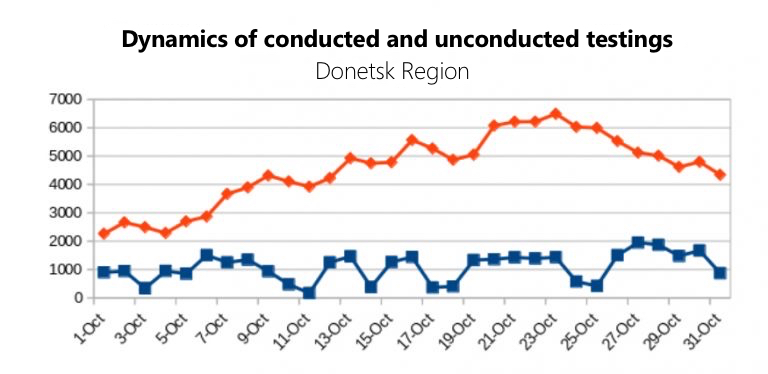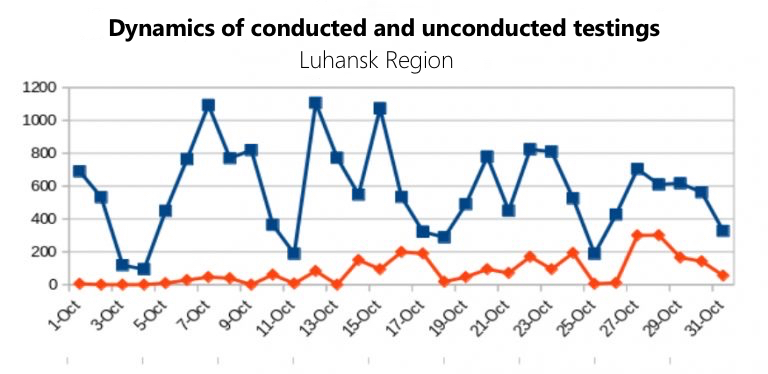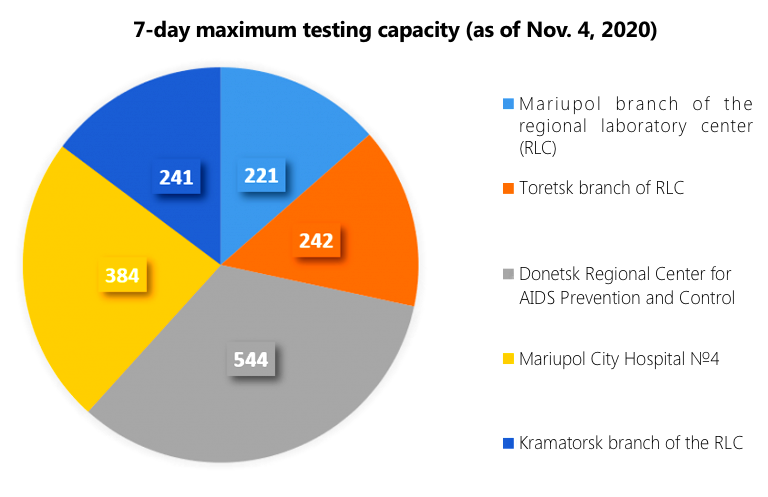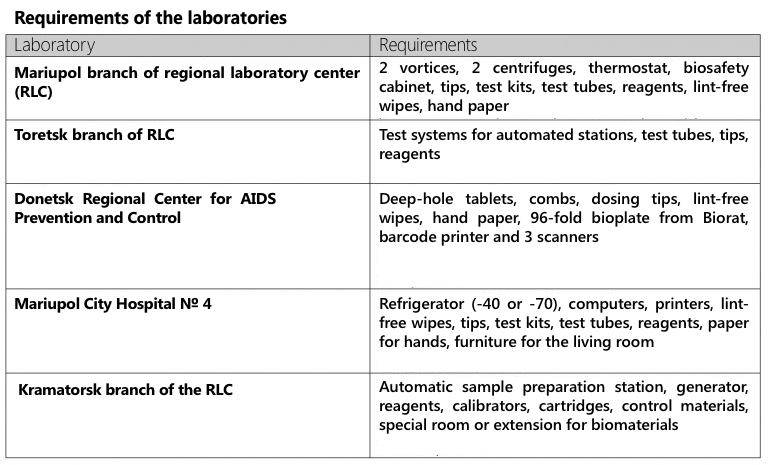-
Unfortunately, nothing was found for your request, you can search for another keyword, or contact us with your question through the feedback form
Search results (25)
All results (25)
Situation with PCR testing on the controlled territories of Donetsk and Luhansk regions
November 19, 2020
For almost five months now, the teams of the Right to Protection CF have been involved in the implementation of the project «Prevention of the spread and response to COVID-19 in areas in eastern Ukraine affected by the conflict». Together with partners from the 3P Consortium and with financial support from the United States Agency for International Development (USAID), we are working to raise awareness of the coronavirus situation and monitor public protection.
Physicians and patients have repeatedly pointed to significant delays in obtaining test results (PCR). The wait could be up to seven days, and sometimes longer. This situation not only undermines the measures to effectively control the spread of infection, because the establishment of contacts begins only after confirmation of the diagnosis, but also deprives the hospitalized of proper treatment. In addition, such delays may also contribute to the spread of the virus among patients and medical staff, given that it is not always possible to isolate patients with suspicion from each other and not all of them end up in specialized medical facilities for coronavirus treatment. Therefore, because of the rapid spread of coronavirus infection in the region, in October we decided to investigate the situation with PCR testing.
From the statistical data it can be seen that the problem mostly concerns the Donetsk region, where the balance of untested samples on October 23 reached the mark of 6490 units. As of November 4, this figure was reduced to 2,425. The average daily capacity of all laboratories involved in October was about 1,393, including state and municipal - 937, while the average revenue - 1,295. 362 of them were in the regional laboratory center, and the last number of the all remaining was only 47.


In terms of the detection rate, both oblasts are very far from the 5% set by the World Health Organization (WHO): 30% for Donetsk oblast and 22% for Luhansk oblast. This can usually indicate not only the prevalence of the virus in the general population, but also selective testing, which may not cover many people with mild symptoms and asymptomatic disease.
One of the indicators that allows us to estimate the coverage of testing is the number of tests per 100,000 population. It is difficult to establish the exact population of the government-controlled territory of Ukraine (GCTU) in Donetsk and Luhansk oblasts, but the approximate number can be calculated by subtracting the number of people living in the uncontrolled territory (data from so-called authorities) from the total population of the oblasts. So, we come to 71 per 100,000 in Luhansk region and 75 - in Donetsk. A comparison with the indicators of neighboring countries (see table below) and the national indicator indicates that even taking into account the population, the number of tests performed is too small.

What can be done?
One of the first suggestions / recommendations that comes to mind is to open the new laboratories. According to the Donetsk Regional State Administration's health department, the region needs at least four more such facilities. It is estimated that the cost of re-equipping the laboratory alone can reach several million hryvnias (1, 2, 3). In addition, it is necessary to train staff. Under favorable circumstances, the time required to open a laboratory can be approximately 2-3 months.
Among the more immediate proposals put forward by the Ministry of Health of Ukraine (MOH) were:
- Use priority systems, which did not change the situation significantly, because among the 2,425 untested samples in Donetsk laboratories, 1,862 were of the first degree of priority.
- Redirect to less busy labs. Used repeatedly. Although, given the rapid spread of coronavirus, chronic under-testing at the national level and the fact that the residue problem still remains, this option is clearly not a reliable solution.
- Test less. The Ministry of Health tried to reduce the workload of laboratories by limiting testing to three groups of people: suspected disease, confirmed diagnosis, and contact persons with symptoms. Thus, the short-term result was proposed to be achieved through a long-term containment strategy.
- Involve private laboratories. Almost 100 million hryvnias were allocated for this. On the most productive day in October, 1950 samples were processed in the Donetsk region, 54% of them by private laboratories. At today's commercial rates, the allocated funds could be enough for three months of such cooperation, but this amount is allocated for the whole country. In addition, testing in private laboratories costs more than in public and communal ones. So, in the long run, it is unclear to what extent the private sector will be able to meet the needs, whether there will be enough money for it and whether it is the optimal investment.
- Use the new rapid antigen tests recommended by the WHO. Their accuracy is expected to be comparable to PCR testing. The Ministry of Health assures that 800,000 will be purchased and delivered in the near future. However, so far such tests are available only in private laboratories at a price of 800 UAH.


Meanwhile, Right to Protection decided to focus on the needs of existing institutions and find out how to increase their capacity. Looking at the reporting of laboratories, the most obvious is the continuation of full-scale work on weekends and holidays, when the number of processed samples is significantly reduced or drops to zero. Although the implementation of this decision may be complicated by the lack of the required number of qualified personnel. So our monitors contacted the labs directly to find out how to increase capacity (see average and maximum power for 7 days on November 4).
As it turned out, many employees at the Luhansk Laboratory Center are currently simply ill. Mariupol City Hospital № 4 may well perform up to 600 tests per day, depending on the needs of the city, given that last week almost 260 tests were performed per day, it turns out that there was no special need. At the same time, in the newest Kramatorsk laboratory there is often a shortage of electricity.
In general, the reserves to increase capacity include:
- Process automation. This is expected to give the largest increase in the number of analyzes performed. In the Toretsk branch of the regional laboratory center (RLC), for example, an automatic sample preparation station (ASPS) was installed, which will soon allow up to 270 tests per day. ASPS in the Mariupol branch of RLC has failed, in case of its restoration productivity can be doubled. Installing its own ASPS in the Kramatorsk branch of the RLC could increase the number of tests per day to 400.
- Introduction of an automated reporting system. It is currently being implemented only in the laboratory of the Donetsk Regional Center for AIDS Prevention and Control. The Mariupol and Kramatorsk branches of the RLC and the laboratory of the Mariupol City Hospital № 4 (LMCH) emphasized that currently manual data entry into a computer takes a long time.
- Staffing and organization of the work process. All laboratories, except LMCH, need more specialists, usually biologists, bacteriologists and immunologists. In the Mariupol branch of the RLC there is an opportunity to arrange an additional job, which requires an increase in staff by 3 people. The Toretsk branch of the RLC pointed out the overcrowding of its two specialists, and the expansion of the staff would make it possible to organize work in two shifts. At the State Securities Commission, specialists are not only forced to work overtime, but also do not yet receive additional payments for the risks of working with COVID-19, so it is difficult to motivate them to work in two shifts.
The voiced needs of laboratories can be found in the table below.

This study was made possible by the significant support of the American people through the United States Agency for International Development (USAID). Responsibility for the content rests on the Right to Protection and does not necessarily reflect the views of USAID or the United States Government.
It is important for us to receive feedback on this material, especially from government officials and NGOs. Please fill out this short form. It will take less than a minute of your time. Thank you!
